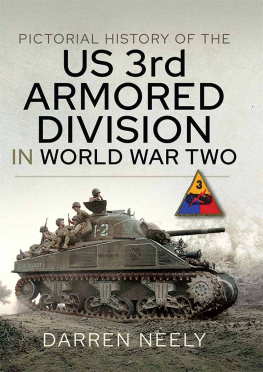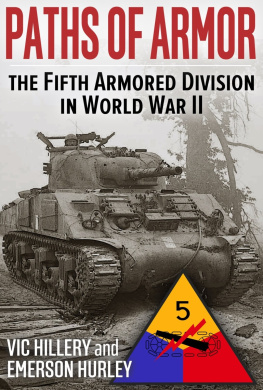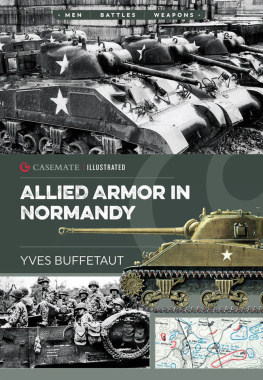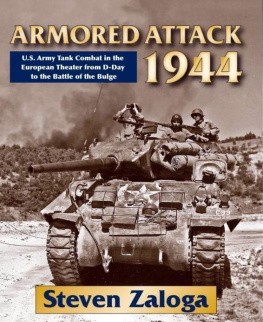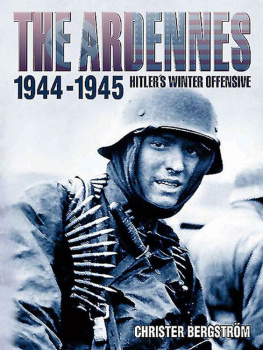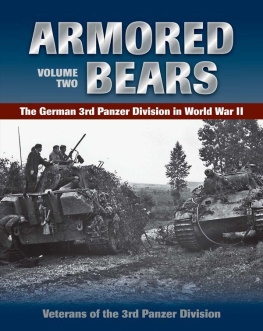Pagebreaks of the print version

PICTORIAL HISTORY OF THE US 3RD ARMORED DIVISION IN WORLD WAR TWO
Pictorial History of the US 3rd Armored Division in World War Two
Darren Neely
First published in Great Britain in 2020 by
Pen & Sword Military
An imprint of
Pen & Sword Books Ltd
Yorkshire Philadelphia
Copyright Darren Neely 2020
ISBN 978 1 52677 551 1
eISBN 978 1 52677 552 8
Mobi ISBN 978 1 52677 553 5
The right of Darren Neely to be identified as Author of this work has been asserted by him in accordance with the Copyright, Designs and Patents Act 1988.
A CIP catalogue record for this book is available from the British Library.
All rights reserved. No part of this book may be reproduced or transmitted in any form or by any means, electronic or mechanical including photocopying, recording or by any information storage and retrieval system, without permission from the Publisher in writing.
Pen & Sword Books Limited incorporates the imprints of Atlas, Archaeology, Aviation, Discovery, Family History, Fiction, History, Maritime, Military, Military Classics, Politics, Select, Transport, True Crime, Air World, Frontline Publishing, Leo Cooper, Remember When, Seaforth Publishing, The Praetorian Press, Wharncliffe Local History, Wharncliffe Transport, Wharncliffe True Crime and White Owl.
For a complete list of Pen & Sword titles please contact
PEN & SWORD BOOKS LIMITED
47 Church Street, Barnsley, South Yorkshire, S70 2AS, England
E-mail:
Website: www.pen-and-sword.co.uk
Or
PEN AND SWORD BOOKS
1950 Lawrence Rd, Havertown, PA 19083, USA
E-mail:
Website: www.penandswordbooks.com
INTRODUCTION
D uring the European Theater of Operations (ETO) in the Second World War, the 3rd Armored Division of the US Army was one of, if not the finest, fighting units fielded by the American Army. The 3rd Armored, known as Spearhead fought in almost every major engagement in the ETO except for the Normandy invasion landings and was constantly at the forefront of the advance of the American and Allied armies as they made their way from France and to the River Elbe of Germany in 1945. The 3rd Armored along with the 2nd Armored were the only armored divisions that were formed under the heavy designation, meaning they had two complete armored regiments with three tank battalions each and an armored infantry regiment, whereas the other standard American armored divisions comprised three tank and three armored infantry battalions each.
In addition to the two armored regiments (32nd and 33rd) and one armored infantry regiment (36th), the division also had three armored field artillery battalions (54th, 67th, 391st), a tank destroyer battalion (703rd), an armored reconnaissance battalion (83rd), an armored engineer battalion (23rd), a medical battalion (45th), an anti-aircraft battalion (486th) and battalion-sized supply and ordnance/maintenance units. The division was typically broken down into two Combat Commands (CCA and CCB) that were centered on the two armored regiments and complemented by armored infantry, artillery, engineers, etc. There was also a smaller combat command, CCR, which was used as a reserve unit when needed.
The 3rd Armored would land on the Normandy beaches in the Omaha Beach sector in mid-June 1944 and make their way to the front lines shortly after. The commander of the division was Major General Leroy H. Watson. The 3rd Armored would soon receive their baptism of fire at Villiers-Fossard on June 29/30 1944 when units of CCA would assist the 29th Infantry Division in straightening the front lines. The tank units of the 32nd Armored Regiment would receive a bloody nose in these initial engagements and quickly come to realize how effective the German anti-tank defenses in the Normandy hedgerows were. By the second week of July the entire division was engaged with the enemy at the front lines and French locations like Haut Vents, Vire, Pont-Hbert and Saint Lo became all too familiar names for the men of Spearhead. In early August, Major General Watson was replaced on the orders of the VII Corps commander Major General Joe Collins, who felt a change was needed. Major General Maurice Rose would assume command and lead the division until his tragic death at the hands of a German tank commander on March 30 1945 near Paderborn, Germany. General Rose was a dynamic commander who had the respect of his men and superiors and was frequently found near the front lines with his troops.
After a brief break to learn from their initial Normandy engagements, including fitting their tanks with steel devices to break through the hedgerows, the 3rd Armored was prepared to lead the Allied efforts to close their end of the Falaise Pocket in August 1944. The 3rd Armored smashed German panzer divisions as they advanced rapidly across France. Fierce battles raged in places like Ranes, Fromental and Mortain as the 3rd Armored began to master tank warfare in the Normandy countryside. By the end of August, the 3rd Armored had completed its sweep across France and was knocking on the door of occupied Belgium. The advance through Belgium was met with cheerful Belgian crowds as they inscribed graffiti on the American tanks as they made their way through the small towns and cities of Belgium.
However, it was here in September 1944 at the Westwall or Siegfried Line of Germany and the area around Stolberg where the 3rd Armored would spend the remainder of 1944 before shifting to the Ardennes to counter the German offensive known as the Battle of the Bulge. A combination of a spirited German defense, weather and quagmires in other sectors near the 3rd Armored resulted in a grueling stalemate in this sector for the American First Army which VII Corps and the 3rd Armored were part of. Towns like Stolberg, Mausbach, Hastenrath, Werth, Geich and Langerwehe are where the 3rd Armored fought a series of slugfests with the German Army in the fall of 1944.
The German counter-offensive in the Ardennes on December 16 1944 resulted in the 3rd Armored Division being sent to the Ardennes of Belgium to assist the VII Corps in first stemming the German advance and then going on the offensive to push the Germans back to their homeland. Defeating crack German SS Panzer Divisions at places like La Gleize, Lierneux, Sterpigny, Ottre and Lomre saw heavy casualties in men and vehicles on both sides, but by the middle of January 1945, the Germans had been soundly defeated and pushed back across their border.
After a few weeks of rest and refitting, including being equipped with ten of the new M26 Pershing tanks, the 3rd Armored was ready for the final push across Germany to end the war. Spearheading across Germany quickly ensued and the first large German city on the Rhine, Cologne, fell on March 6 1945. It was here that the 3rd Armored would again gain notoriety with the famous Pershing versus Panther duel at Cologne Cathedral. (Note to readers: if you havent read Spearhead by Adam Makos yet, please do yourself a favor and do so immediately for an in-depth look at the life of a 3rd Armored Division tanker and also the famous tank duel at Cologne Cathedral.) Soon the 3rd Armored would be off to assist in their part of closing the Ruhr Pocket which, after General Roses death on March 30 1945 near Paderborn, would be known as the Rose Pocket. After the closing of the pocket the 3rd Armored would continue its lightning advance against spirited last-ditch resistance in small German towns in the Harz region before taking the city of Dessau and liberating Nordhausen concentration camp in late April of 1945. It was near here on the western side of the River Elbe that Spearhead ended its advance and would celebrate the end of the war in Europe in May 1945.

